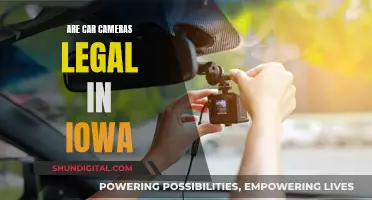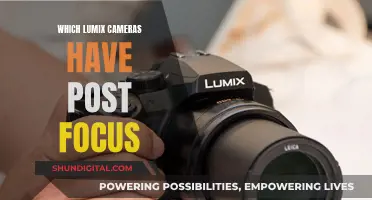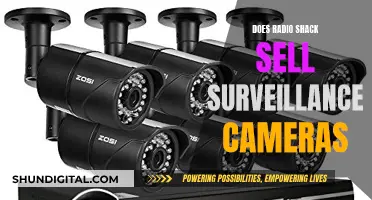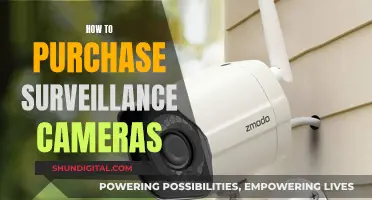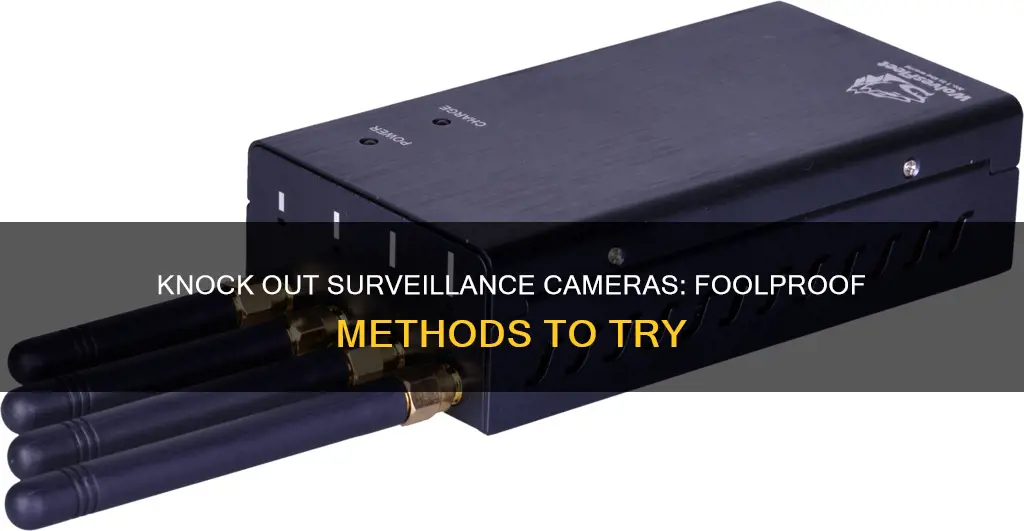
There are many reasons why someone may want to disable a surveillance camera. This could be to protect their privacy, as in the case of Airbnb guests who have discovered hidden cameras in their accommodation, or to avoid being identified while doing something illegal. While it is legal to hide yourself from surveillance cameras, it is important to note that disabling them may be illegal and could result in criminal charges or civil lawsuits.
There are several ways to knock out surveillance cameras. One way is to use a deauthentication attack, which disrupts the connection between the camera and the Wi-Fi access point, forcing the camera offline. This method requires minimal skill and equipment. Another way is to physically block the camera's lens by covering it with tape, a bag, or fabric, or by smearing it with petroleum jelly. You can also shine a bright light or laser pointer directly into the lens to obscure the image. However, this method requires precision and quick action, as any slip in the laser's aim will reveal your face.
| Characteristics | Values |
|---|---|
| Method | Use a flashlight, laser pointer, IR lights, or spray paint to block the camera's lens. You can also use a VPN or a "watch" device to disable WiFi cameras. |
| Effectiveness | Methods like flashlights, lasers, and IR lights may only work in the dark and require precision to execute successfully. Spray paint is not practical as it will trigger motion detection. |
| Legality | Methods that involve physically tampering with or destroying the camera, such as using spray paint or cutting wires, are generally illegal and can result in criminal charges. |
| Risks | Using a laser pointer may damage your eyes if not used carefully. |
What You'll Learn

Use a laser pointer or flashlight
Using a laser pointer or a flashlight is one of the methods to knock out surveillance cameras. However, it is important to note that this method has its limitations and risks, and may not always be effective or legal. Here are some detailed instructions on how to use a laser pointer or flashlight to attempt to knock out surveillance cameras:
Choose the Right Laser Pointer
Not all laser pointers are created equal. The power and colour of the laser pointer can make a difference in its effectiveness. Higher-powered laser pointers are more likely to be successful in knocking out a surveillance camera. Additionally, green lasers are more visible than other colours, making them a popular choice for this purpose.
Understand the Risks and Limitations
It is important to recognise that knocking out a surveillance camera with a laser pointer is a temporary solution. The effect usually wears off after a short period, and it may not cause any permanent damage to the camera. Additionally, the camera will continue to record until the laser pointer is accurately aimed at the lens, so precision is crucial. Furthermore, if anything comes between the laser and the camera, the camera will immediately be able to record again.
Be Aware of Legal Consequences
Using a laser pointer to knock out a surveillance camera may be considered illegal in some jurisdictions. Camera blocking technology, including lasers, LEDs, and spray paint, is generally prohibited and can result in criminal charges or civil lawsuits. Therefore, it is essential to understand the laws in your area before attempting this method.
Execute the Technique
To use a laser pointer or flashlight to knock out a surveillance camera, you must first locate the camera and then direct the laser or light beam directly into the camera lens. It is crucial to maintain a steady aim and ensure that the beam does not slip away from the lens, as this will immediately render the method ineffective. This technique may work during the day or night, but it is likely to be more effective in darker conditions.
Take Precautions
When attempting to knock out a surveillance camera with a laser pointer, it is important to take precautions to protect yourself and your surroundings. Avoid pointing the laser into your eyes, as it may cause blindness. Consider wearing protective eyewear, but keep in mind that it may not provide complete safety. Additionally, ensure that the laser does not reflect off any surfaces and hit any unintended targets.
Combine with Other Methods
For a more comprehensive approach, consider combining the use of a laser pointer or flashlight with other security measures. Implement motion detection sensors, alarms, physical barriers, and alternative security measures such as jamming signals or physical tampering. By creating a multi-layered security system, you can increase the chances of successfully knocking out surveillance cameras and enhancing overall security.
XR Night Mode Camera: Is It Possible?
You may want to see also

Block with trees, fences, or curtains
Blocking surveillance cameras with trees, fences, or curtains is a legal and effective way to protect your privacy. Here are some detailed instructions on how to do it:
Planting Trees and Shrubs
Strategically planting tall trees or dense shrubs along the boundary between your property and your neighbour's can effectively block the view of the security camera. When choosing plants, opt for those that provide year-round coverage and can grow to an appropriate height. This method not only helps with privacy but also adds a natural and aesthetically pleasing element to your space.
Installing Privacy Fences or Screens
If you prefer a more physical barrier, installing a privacy fence or screen along the property line can effectively block the camera's view of your house. Just be sure to comply with local regulations and respect your neighbour's property rights. This option provides a more permanent and sturdy solution.
Using Natural Barriers
If planting trees or installing fences is not feasible or desired, consider tall hedges or trellises with climbing plants as natural barriers. These options create visual barriers while still allowing airflow and sunlight to pass through. It's a softer approach that blends well with the surroundings.
Hanging Curtains or Installing Privacy Screens
Depending on local laws and regulations, hanging thick curtains or installing privacy screens on your windows can be a simple yet effective way to prevent the camera from capturing your property. This option allows you to adjust the level of privacy by opening or closing the curtains as needed.
Installing Fence Extensions
If you already have a fence, consider adding fence extensions to increase the height and create a more formidable barrier against prying lenses. This solution is especially useful if the surveillance camera is positioned higher up, requiring a taller obstacle to block its view.
Remember, while these methods are legal and recommended ways to protect your privacy, it is always a good idea to communicate openly with your neighbour about your concerns. Express your feelings properly, and politely ask them to adjust the angle or position of their cameras. Open communication can often lead to a mutually agreeable solution without the need for more drastic measures.
DC Camera Tickets: Violation or Not?
You may want to see also

Hide your face with a mask or glasses
Surveillance cameras are everywhere, from malls to street corners, and even on your neighbour's property. While the use of surveillance cameras is justified in some cases, such as monitoring illegal activities and protecting homes, it can also violate the privacy of others. If you wish to avoid being identified by these cameras, one method is to hide your face with a mask or glasses. Here are some ways you can do this:
Wear a Mask:
The simplest way to avoid facial recognition is to cover your face with a mask. During the pandemic, many people already do this for health reasons, and it effectively prevents biometric face unlocking. While it is possible to identify someone with a half-face mask, it is much harder to do so using public security cameras. However, keep in mind that full masks may not be practical due to anti-mask laws in certain areas.
Wear Sunglasses:
Sunglasses, especially when paired with a face mask, can be an effective way to prevent your face from being scanned. Traditional sunglasses block the eyes, which are key facial features used in recognition algorithms. Additionally, sunglasses can be paired with other disguises, such as a wide-brimmed hat, to further obstruct the view of your face.
Use Makeup:
There is a new style of makeup specifically designed to confuse machine vision systems. This "dazzle" makeup can be applied to obscure your facial features and make it more challenging for recognition software to identify you. However, this method may not work for everyone, and it could make it difficult to see clearly.
Wear Clothing with Printed Faces:
While this won't stop your face from being scanned, it can trick the system into scanning the wrong face. By wearing a t-shirt or carrying an object with a printed face, you can confuse the algorithm and mislead the surveillance system.
Utilise Infrared (IR) LEDs:
Infrared LEDs embedded in clothing can overwhelm photo diodes in IR-sensitive cameras used for surveillance. Since IR waves are invisible to humans, they don't obstruct normal behaviour, making it an ideal way to hide in plain sight. However, this method may not perfectly obscure your face, and it could make you more noticeable to security personnel.
Use Special Privacy Glasses:
Reflectacles is a company that offers specialised privacy glasses designed to defeat facial recognition. These glasses use infrared-blocking lenses and reflective frames to blind cameras without causing any damage. This technology can be a more convenient and subtle way to protect your privacy while still allowing you to see clearly.
How to Prepare Your Polaroid Camera for Instant Shots
You may want to see also

Use a VPN to block the camera's WiFi
Using a VPN to block a camera's WiFi can be an effective method to enhance your security and privacy. Here's a detailed guide on how to do it:
Choose a Reputable VPN Provider
First, select a VPN provider that suits your needs, especially one that is compatible with routers. Avoid free VPN services, as they often come with data and speed limitations, and may compromise your data by selling it to third parties. Opt for reliable providers like PureVPN or NordVPN, which offer specific features for secure remote connections.
Get a VPN-Compatible Router
Not all routers support VPN connections, so ensure you have a VPN-compatible router. Some VPN providers offer pre-configured routers, making the process more straightforward. If you prefer to use your own router, you can set up the VPN yourself, but the process differs for each router model.
Configure the VPN on Your Router with a Dedicated IP
Setting up the VPN on your router involves creating an encrypted tunnel for data travelling between your devices and the VPN server. Consult your VPN provider's instructions for specific steps on configuring the VPN for your chosen router model. During setup, be sure to use a dedicated IP address, which will provide a consistent and secure way to remotely access your camera feeds.
Set Up Port Forwarding
As your security cameras are now behind the VPN's encrypted tunnel, you'll need to forward specific ports to the cameras to access them remotely. Port forwarding directs incoming requests on those ports to the correct device on your network. Consult your VPN provider's instructions or general online resources for setting up port forwarding on your router.
Enhance Camera Security with Additional Measures
Using a VPN adds a strong layer of protection to your camera system. However, you can further enhance security by implementing basic measures such as creating strong passwords and regularly updating your camera's firmware. These steps will make your cameras more resilient to hacking attempts and unauthorized access.
By following these steps, you can effectively block a camera's WiFi connection using a VPN, ensuring your privacy and security while also maintaining remote access to your camera feeds when needed.
The Evolution of the UDSC15 Camera: Still in Production?
You may want to see also

Talk to the camera owner
If you're concerned about a surveillance camera and want to know how to deal with it, the first step is to identify who owns the camera. The owner might be your neighbour, a private company, or a government entity. Once you know who owns the camera, you can take the following steps to address the issue:
- Talk to the camera owner directly: This is often the most straightforward and effective approach. Start by politely expressing your concerns and explaining how the camera is invading your privacy. For example, you could say something like, "I've noticed that your camera is pointed towards my window and backyard, and it's making me uncomfortable. Would you be willing to adjust the position or angle of the camera to respect my privacy?" Most people will be reasonable and willing to work with you to find a solution.
- Seek mediation: If talking directly to the camera owner doesn't work, consider seeking help from a mediator. Contact your local community justice centre or neighbourhood mediation centre to explain the situation. They can help facilitate a conversation between you and the camera owner to resolve the issue without further escalation.
- Understand your legal rights: It's important to know your rights when it comes to surveillance cameras. In general, you have the right to privacy in certain areas, such as your home, and there may be restrictions on where cameras can be placed. Consult with a lawyer or legal professional to understand the specific laws and regulations in your area regarding surveillance cameras.
- Block the camera's view: If the camera is still causing you distress, you can try to block its view without tampering with the camera itself. For example, you can plant trees or shrubs, put up fences or curtains, or place objects in the camera's line of sight to obstruct its view.
- Install your own camera: If the camera owner is unwilling to cooperate, you could try installing your own camera to monitor their activities. This may not be the most peaceful solution, but it can help you keep an eye on the situation and gather evidence if needed.
- Contact the authorities: If you feel that the camera is being used for malicious purposes, such as stalking or domestic abuse, don't hesitate to contact the police or relevant authorities. They can provide guidance and support and may be able to intervene if any laws are being broken.
Remember, it's important to handle this situation calmly and respectfully. Avoid taking matters into your own hands by tampering with or destroying the camera, as this could lead to legal consequences.
Speeding Tickets: When to Expect That Camera Ticket
You may want to see also


